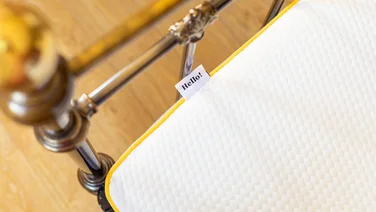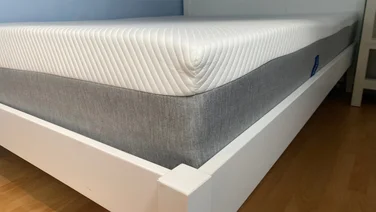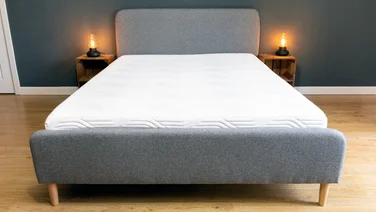To help us provide you with free impartial advice, we may earn a commission if you buy through links on our site. Learn more

If you’re in the market for a mattress, you’ll know that the best mattresses tend to come with a hefty price tag. Many modern mattresses-in-a-box are very reasonably priced – particularly if you can take advantage of seasonal sales or special offers – though, even with discounts you’re still spending hundreds of pounds.
Whereas, if you look on any selling site and you’ll find mattresses being offered for very little money, which makes it very tempting to consider buying second-hand – particularly if you’re on a tight budget – but is it wise?
In this guide, we’ll look at whether pre-owned mattresses are safe and help you decide whether you should buy second-hand or save up for one that’s brand-new.
Are second-hand mattresses safe?
In general, we wouldn’t recommend a second-hand mattress – as we’ll explain shortly, it could be unsafe for a number of reasons – the only exception being if a trusted friend or relative is getting rid of a mattress, and they can verify its entire history. However, even then it’s important you do the relevant safety checks and deep cleans to ensure a happy and healthy night’s sleep, or you risk potential problems and issues.
READ NEXT: Best cooling mattresses
Why shouldn’t you buy a second-hand mattress?
There are several reasons not to buy a second-hand mattress, some more serious than others, but these are all-important points to consider:
1. Health and hygiene
“There’s potential for a second-hand mattress to harbour bacteria, mould, dust mites and bodily fluids from previous owners, not to mention bedbugs”, explains Dr Chester Wu, a double board-certified psychiatrist and physician, sleep expert and medical reviewer at Rise Science. “I’d advise a thorough inspection, checking for signs of infestation, mould, noticeable odours, stains or wear and tear. Look closely at seams and crevices for any pests or eggs.”Our guide on how to get rid of bed bugs will help you to know what to look for, and how best to deal with these pests, but as Dr Wu points out: “Bedbugs can be difficult to eradicate once they infest a mattress, and can spread easily.”
Even if a second-hand mattress appears to be in good condition, or you’ve acquired it from friends or family, you should still give it a deep clean before you even consider sleeping on it. “You can try cleaning
[the mattress]
yourself, using a steam cleaner to kill dust mites and bacteria, and a vacuum cleaner with a HEPA filter to remove dust and allergens”, explains Dr Wu. “Or consider having it professionally cleaned instead. The benefit here is professionals have the tools and the know-how.
“After cleaning, allow the mattress to air out in a well-ventilated area or in sunlight, to remove any residual odours. Lastly, encasing the mattress in a high-quality, bed bug-proof mattress protector can help with dust mites and allergens, make it easier to clean in the future, and help to prevent future damage.”
READ NEXT: Best mattresses for heavy people
2. Safety features
New mattresses must follow stringent rules to ensure they’re safe for customers to buy. The most important of which is the fire safety accreditation. In the UK, mattresses must comply with standard BS 7177, for their resistance to ignition from smoking materials such as cigarettes and matches.
In addition, the fillings must comply with the cleanliness standard BS 1425-1:991, and manufacturers must also ensure that all chemicals used in production are REACH, POP and EU Biocidal Product Regulations compliant. As you can tell, there are a lot of rules new mattresses must adhere to, but if you buy a mattress second-hand, it may not have the correct labelling and you’ll have no guarantee it has passed these tests.
3. Lack of support
“A second-hand mattress may not provide the same level of support and comfort as a new one due to wear and tear”, points out Dr Wu. “A helpful shortcut is to consider the mattress’s age. Mattresses are typically recommended to be replaced every 7-10 years. If the mattress is older than 10 years, it’s unlikely to be worth salvaging.”
Knowing how often you should change your mattress can help avoid problems with the materials inside starting to degrade. Over time, foams will start to break down and springs can shift, break or even poke through, causing lumps, bumps and uneven surfaces. If a second-hand mattress has an uneven surface, it’s likely to struggle to support your body properly, potentially leading to aches and pains. As Dr Wu advises, “If you wake up in the morning with new aches or pains, or if an existing pain or injury feels worse, this is another good sign the mattress is past its prime.”
4. Limited options
Today’s market is flooded with different types of mattresses in a wide range of materials, including memory foam and latex, as well as the traditional sprung style, so it’s easier to find a mattress that suits your body and sleeping style if you buy new. If you’re buying a second-hand mattress, you won’t have anywhere near as many options to choose from.
If you decide to invest in a new mattress and aren’t sure where to start, our guide on how to choose a mattress will help.
5. No trial period, guarantee or warranty
One result of the explosion in the online mattress market is that brands usually offer a trial period with their mattresses as you can’t go to a brick-and-mortar store to try them out. This is particularly important since, as Dr Wu explains, “One night won’t be enough to try out a mattress – unless it’s immediately and unambiguously uncomfortable – as it can take us some time to acclimate to new sleeping arrangements.”
You’ll generally find that manufacturers offer a minimum of 100 nights to try out their mattresses and include a guarantee or a warranty in case of any major faults or failings. By comparison, used mattresses are sold ‘as seen’ and warranties generally can’t be transferred from the original owner, which means that if something goes wrong, you won’t have any protection.
6. No delivery or collection of your old bed
Mattresses are big and bulky. The manufacturers know this and it’s why so many mattresses are delivered to your door vacuum-packed into a box – to make it easier to move them around your house. Many brands even offer the option for a new mattress to be delivered right to your bedroom, with your old mattress taken away and recycled as part of the same service.
Buying a mattress second-hand means that you have to deal with all the logistics yourself. You’ll need a vehicle large enough to transport a mattress to actually get it to your house – maybe even hiring a van, which somewhat negates the savings – and you’ll probably also need at least two people to move it and get it up to your bedroom.
And then what to do with your old mattress. We’ve covered this extensively in our guide on how to dispose of an old mattress but, as you’ll read, it’s not always the easiest thing to do either.
READ NEXT: Best hybrid mattresses
What are the alternatives to a second-hand mattress if I can’t afford a new one?
If you (wisely) decide that a second-hand mattress isn’t the best or safest option, but still can’t quite justify the expense of brand-new, what are some viable alternatives?
1. Mattress topper or pad
Neither of these will fix a damaged or old mattress, but they might help to extend its lifespan. Dr Wu explains more: “You can consider using a mattress pad to provide a layer of cushioning, which can improve the overall comfort of your bed. However, a mattress pad can’t significantly alter the core support structure of the mattress. If the mattress is sagging or has lost its structural integrity, a pad won’t be sufficient to correct these issues. Proper spinal alignment during sleep is crucial for restorative sleep and to avoid pain.”

Check out our pick of the best mattress toppers on the market for some great examples to choose from if you want to try this option.
2. Ex-display mattress
There are still plenty of brick-and-mortar stores selling mattresses. And you’ll often find that these stores will sell ex-display models to make room for new stock. Of course, these mattresses won’t be pristine – they’ve been tested out by potential customers lying on them – but they’ll still have years of life left in them. Plus they will be delivered and come with guarantees.
3. Refurbished mattress
Because a lot of mattress companies offer trial periods these days, some mattresses will inevitably end up being returned. Some manufacturers recycle these mattresses, while some refurbish or repair them before selling them on at a lower price. Another advantage of buying a refurbished mattress is that they will have been thoroughly cleaned and inspected to ensure they meet quality, safety and hygiene standards. And, again, they will be delivered and come with a warranty.






